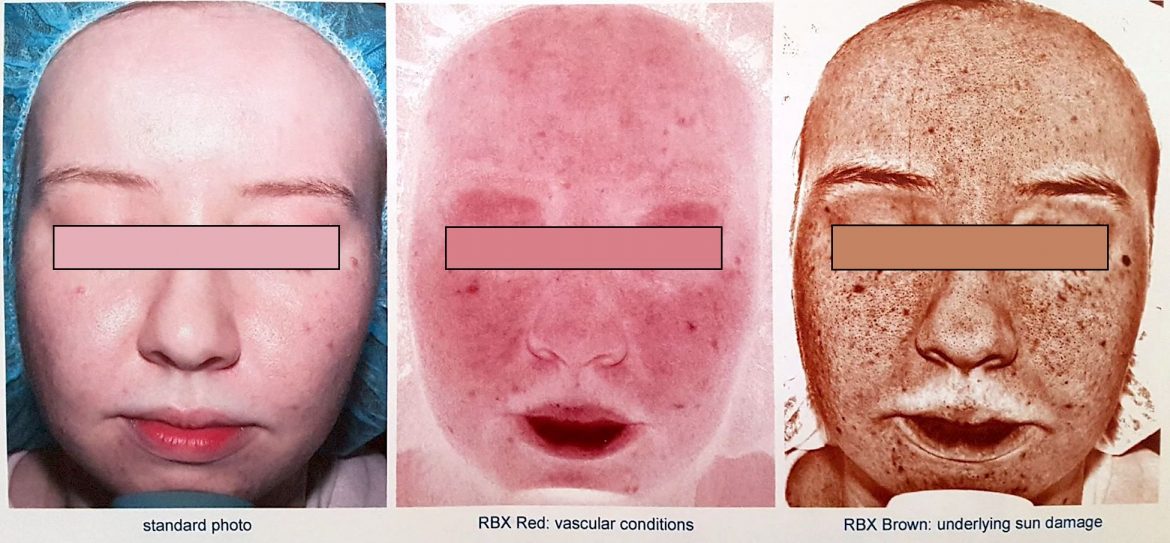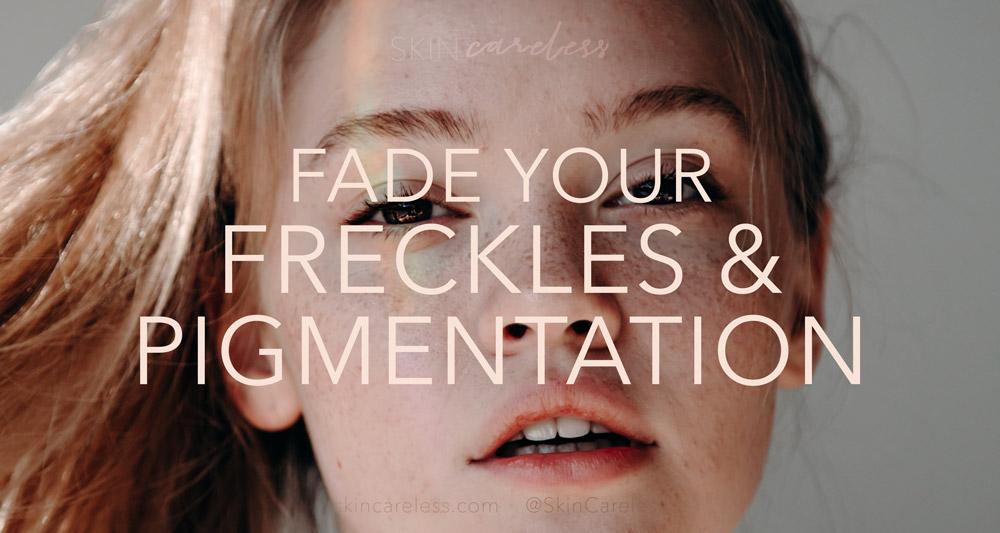Dullness and uneven skin tone can affect anyone – whether you’re a 20-something sun bunny, an avid outdoor sportsman or a middle-age new mum. It’s unlikely you’ll live out your life totally escaping its influence in one way or another.
The causes of these seemingly varied issues with different names – freckles, post-inflammatory hyperpigmentation (aka. PIH), and melasma – are all variations on the same underlying skin function: pigmentation.
What causes pigmentation problems?
Everyone’s skin is naturally pigmented to a certain degree. Melanin gives skin its ‘brown’ or depth of colour, and is produced by skin cells called melanocytes.
These melanocytes can be triggered into action by both hormones and UV exposure. When this happens, the receptors in some lucky people are overly-excitable and start to create too much melanin as a self-defense response.
Problems like melasma and freckles arise a result of a build up of excess melanin in the skin as compared to your ‘usual’ skin tone.
What do pigmentation problems look like?
Pigmentation isn’t always as obvious as full-blown freckles or a big patch of brown melanoma. Maybe you’re suspect, but not sure if pigmentation really is what’s giving your skin a dull appearance.
A great way to be sure is by using a pigmentation-spotting light.

For example, I have very lightly freckled skin, as you can see in the leftmost picture above. But when put under this special light that picks up on deep down pigmentation (far right), it’s easy to see there’s a lot more lurking under the surface. You can see something similar yourself if you have a UV black light at home.
To spot it with the naked eye, look out for uneven looking skin, even when you don’t suffer from acne, scarring or deep signs of ageing. When there’s patches or deep-down pigmentation, it can give the appearance of subtly blemished, textured or dull skin. A little test you can perform is by gently tugging on your skin. What you might have thought was discolouration – say, around the eyes – moving along with the skin is a dead giveaway that that’s actually a pigmentation issue.
Tips for preventing pigmentation: be patient & wear sunscreen
To really come out on top of pigmentation issues, you’ll need a lot of patience – they can be reversed in many cases, but it takes time. It took time to accumulate the excess pigment, and it’ll take time to fade it too!
A hugely important factor to the success of your pigmentation treatment is whether or not you use sunscreen. By using strong anti-pigment products that can sometimes leave your skin sun-sensitive, not wearing any sunscreen, and then getting too much unprotected exposure (which is impossible to avoid, even in the winter), you’ll see virtually no progress – you’ll undo all your hard work, and then some. So do yourself a favour and pair all these products with liberal every day application of an appropriately high-SPF sunscreen.
Want something lightweight and moisturising? The gel formula of Missha All Aound Safe Block should do the trick. Or for mattifying action, Biore UV Milk will keep you shine-free all day.
Affordable products that tackle pigmentation
If you struggle with confidence in your skin because of a pigmentation-related issue, instead of just wishing it away, you should put products in your routine that include specific ingredients to reduce your underlying pigmentation to achieve a more even and clear complexion.
Though a good routine with exfoliating actives and sunscreen will improve the look of pigmentation over time, the best products work by specifically interrupting the melanin production process, to slowly wear away pigment already present, and reducing the likelihood it’ll come back in the future.
The key, as always, is really learning about your products and searching for certain ingredients. And lucky for us, getting started on a budget is easier than ever. Keep your eyes peeled for these easy-to-find and super effective anti-pigmentation ingredients.
Vitamin C
Vitamin C, in many of its forms (hint: look for ‘ascorb-‘ to find the vitamin C derivative) is currently considered the pinnacle of anti-ageing. It’s a potent antioxidant that can prevent sun damage and trigger the growth of healthier skin. But it has the added benefit of being a fantastic pigmentation treatment. Vitamin C interrupts the creation of new melanin by interfering with tan enzyme (tyrosinase) needed to produce new melanin, thus preventing worsening of your skin and allowing it time to fade back to a baseline level of pigment. (Read more about the science of Vitamin C and our bodies here).
Vitamin C is unfortunately highly unstable by nature, reacting poorly to both light and water and turning into orange-coloured useless water. So while there are a lot of Vitamin C products on the market, only a few are designed so as to be maximally effective:
I’m currently testing out the cult-favourite Melano CC serum (and loving it!).
My personal go-to recommendation is the cheap and simple The Ordinary Ethylated Ascorbic Acid 15% Solution. They have a ton of Vitamin C options, though, so check them out.
Pairing Vitamin C with an antioxidant like Ferulic Acid is a surefire way to increase its potency and stability, as in Mad Hippie Vitamin C Serum with Konjac Root, Hyaluronic Acid, and Ferulic Acid.
If you’re looking to splash out and get a luxurious, highly effective product with wonderful ingredients, look no further than the coveted Drunk Elephant C-Firma Day Serum with 15% Ascorbic Acid.
Azelaic acid
It’s not only effective for treating rosacea, acne and UV-triggered free radical damage, but azelaic acid has also shown promise in lightening melasma and hyperpigmentation as well, without the risks that come along with hydroquinone, especially on darker skin tones (read more here).
Similar to Vitamin C, Azelaic acid interferes with pesky Tyrosinase, while also being a lot more stable against degradation.
Unfortunately, it’s currently very difficult to source in high enough concentrations in the United States.
As always, The Ordinary is to the rescue with a simple and affordable product that won’t irritate your skin with unnecessary ingredients, in The Ordinary Azelaic Acid Suspension 10%.
You can also get Finacea prescription gel at a strength of 15% from a dermatologist.
Niacinamide
Not only is it unique in that Niacinamide (also called Vitamin B3) is more famous for its nutritional value, but Niacinamide also works in a different way than most other pigmentation-fighting ingredients – by preventing melanocytes from passing on the pigment they create to keratinocytes, which are the regular unpigmented skin cells. It also has a ton of other benefits, including reducing oil production, boosting skin collagen and protein levels, incredible soothing power and anti-redness abilities.
The Ordinary does it again with their Niacinamide 10% formula, that also harnesses the power of 1% Zinc to fight acne, eczema and inflammation at the same time.
Treatments for more stubborn pigmentation
Pigmentation is one of the trickier skin problems to beat, so for some people, over-the-counter everyday products just aren’t going to cut it. Here’s what to consider when you’re in that boat:
In-office treatments: IPL, lasers and deep peels
If you suffer from extensive or dark pigmentation, your best bet may be going to a medical aesthetician and undergoing a series of treatments to really break up the pigment you’ve got. Otherwise, it’s a little like fighting an uphill battle. A range of options from IPL to TCA peels can help you get back to a clean slate and use the at-home ingredients to keep your skin clear in the future.
Prescription-only Hydroquinone
For large and deep areas of hyperpigmentation, your doctor or skin specialist might consider the use of hydroquinone: known as the big guns when it comes to reversing severe pigmentation issues. This ingredient will actually reduce the amount of melanin your skin is capable of producing. Over time, it can ‘bleach’ the skin even beyond natural levels, so it’s something to treat very seriously. Apply only to pigmented areas and never on unaffected skin.






[…] the most well-known antioxidant product is Vitamin C serum, touted for brightening pigmentation and increasing collagen production. The Ordinary, Mad Hippie, and more offer these serums. Vitamin […]
[…] it potentially the most gentle AHA of all. Mandelic acid has the ability to reduce acne marks and pigmentation, and reverse the loss of elasticity and firmness associated with skin […]
[…] Pigmentation lightening […]
[…] Some of my favourite actives include Salicylic Acid or Niacinamide + Zinc for milder, congestive acne, Benzoyl Peroxide for more severe inflammatory acne, Mandelic Acid for texture and Vitamin C for pigmentation. […]
[…] even take an extra 30 seconds. Your skin will improve in every possible way, from faded pigmentation to reduced inflammation, and future you will thank you for the extra years out of your skin (and […]
[…] which can come across as dullness. If you’ve already got a lot of sun, here’s more tips on how to fade freckles and pigmentation. To also boost your glow on a given day, use a dewy finish sunscreen. My favourite for the task is […]